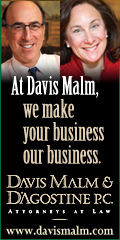
| April 2012 | Past Issues | Advertise |
The Focus for Engaging the Generations
Before we get to the first focus area, I want to summarize what you might already know (or have some background in): the four distinct groups of employees that make up the work force today: · Traditionalists (ages 67 – 90) are the smallest portion of the workforce. About 95% of the Traditionalists are retired from the workforce. Traditionalists tend to be loyal, respect authority and find technology challenging. They are loyal to country and company. · Baby Boomers (ages 48 – 66) are currently the largest living generation with about 51 million people currently in the workplace. They are often described as skeptical workaholics that tend to question authority. Boomers are loyal to themselves and family (and company third). · Generation X (ages 31 – 47) is a highly adaptable generation making up about 41 million of our workforce. Gen X employees tend to be somewhat cynical; they value work-life balance, think globally and are unimpressed by authority. They are loyal to their family and their boss (significant shift in company loyalty). · Gen Y, aka Millennials (ages 12 – 31) is growing and will soon be the largest portion of the workforce. They are characterized as optimistic team players with an enthusiasm for change and respect for authority. Gen Y is loyal to their social network and family. Most of what is produced on this topic focuses equally on these generations with a particular emphasis on why it is so difficult bringing them together in the workplace. These three focus areas will help bring the generations discussion into a manageable dialog. Focus on What is Ahead According to the U.S. Bureau of Labor [1] estimates, Generations X and Y will be 103.6 million strong by 2014 while the Baby Boomer workforce population will fall to 47.6 million (no statistics were available for the much smaller Traditionalist workforce). The focus of business must be on hiring and retaining these three generations, with particular emphasis on Generation Y. Generation Y will make up 39% of the workforce within two years. With a Baby Boomer retirement rate of almost 1.5% annually, it won’t be long before Generation Y’s size in the workplace increases even more. We can’t forget Gen X – their age group places them at the point in their careers to take on significant leadership positions. It’s easy to see how Generations X and Y will be the dominant workforce for a long time to come. This is not to say we should ignore the other two generations. On the contrary, employees in the Baby Boomer and Traditionalist generations can be excellent mentors, and being mentored is highly valued by both Generations X and Y. It will be important for firms to leverage the strengths of these older generations to support and develop those that follow. Focus on the Similarities Studies suggest that there are three similarities shared by the four generations. Let’s examine each similarity: Achievement All generations have achievement in their list of characteristics. All want to do a good job, accomplish goals, and see the organization succeed. Contrary to the opinion of some of their Boomer work colleagues, Generation Y is very achievement oriented. Remember, this is the generation who took SAT prep courses, went to sports and band camps during the summer months, and longed for the sports trophy, even if the team lost! Camaraderie A sense of belonging is a key to employee engagement no matter the generation. While each individual is motivated by different levels of affiliation, a common denominator seems to be that they want to belong to something greater than themselves. They want to be proud of the organization they work for and be a part of its success. Equity The fairness issue rears its ugly head more often than we’d like, but equity for employees of all generations comes down to fairness in: · Pay – this doesn’t mean they all have to be paid the same, just that there’s structure and fairness to the pay scale. · Benefits – the days of the "executive" cafeterias and parking should be in the past. Employees of all generations oppose a class system within company benefits – even the Traditionalists know it is no longer an incentive to engagement. · Opportunities to develop – all employees see themselves as potential candidates to grow and develop. For instance, recent studies tell us that Generation Y is three times more motivated by training opportunities than money. Focus on Yourself How do you adapt to the changing generations? Look at how you are addressing these three areas: Turnover Statistically, Gen Y employees stay around a whopping 18 months before searching for additional challenges. Once they leave, don’t underestimate the effect this has on their colleagues (the Pied Piper Effect). There are two ways to handle this: 1) Let employees "quit" their jobs but stay in the company via job rotations 2) When an employee does leave the company, stay in touch with the intention of bringing him/her back 18, 36 or even 54 months down the road. In other words, cultivate boomerang employees, don’t just hope for them. Policies Do you have an Internet policy? How about a phone policy? Is it against policy for someone to work at home? Generation X and especially Gen Y grew up on technology and will have a difficult time understanding a lack of flexibility in the policies that restrict the use of technology. Step back and take a look at what policies are preventing new employees from joining your company, or staying. Allowing your employees reasonable access to social media can be a significant branding, engagement and communication tool. Promotions I remember seeing a job posting for a Project Manager that said, "Must have 10 years with the company." We need to stop thinking in terms of age and years of experience and more in terms of behaviors, traits, and demonstrated abilities. Somebody from Generation Y may be perfect for the position, and if they aren’t considered, will look to go somewhere else. You should diminish tenure as a job requirement. I’ve always believed in finding the common denominators in every topic. By focusing on future trends, similarities rather than differences, and your own flexibility, the challenges you face working with four generations can be more manageable and your solutions more effective. Bob Kelleher in partnership with NEHRA will be presenting Typewriters to Tablets – Engaging the Generations on May 31 at the Forefront Conference Center. Join us for this engaging and interactive workshop with an emphasis on the X and Y Generations! And, don’t miss the opportunity to combine this workshop with our Disrupt – Recruiting and Branding in the Social Era. Bob Kelleher, founder and CEO of The Employee Engagement Group, is a noted speaker, consultant, and author of LOUDER THAN WORDS: 10 Practical Employee Engagement Steps That Drive Results, and CREATIVESHIP: A Novel for Evolving Leaders. An in-demand industry speaker and thought leader, Bob spent 25 years working in the HR profession, most recently as Chief Human Capital Officer for AECOM. He can be seen or heard on national media (most recently on CNBC, CBS Radio, and Fox Radio); is a frequent guest writer on many national publications; and is a contributing editor on Boston.com, Monster.com, and Hotel Executive. [1] All statistics used in this article are U.S. only. |
|
303 Wyman Street, Suite 285, Waltham, MA 02451-1253 |
 |



